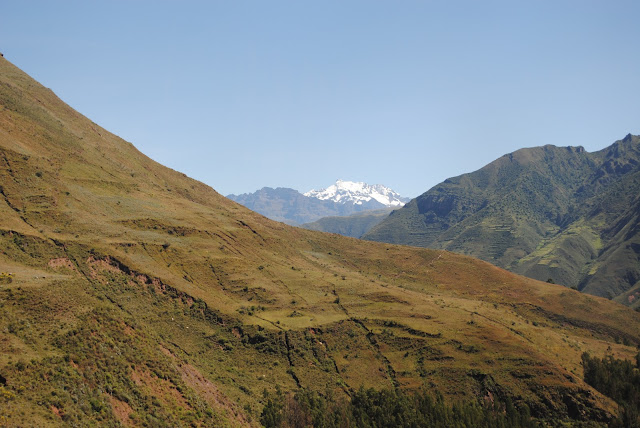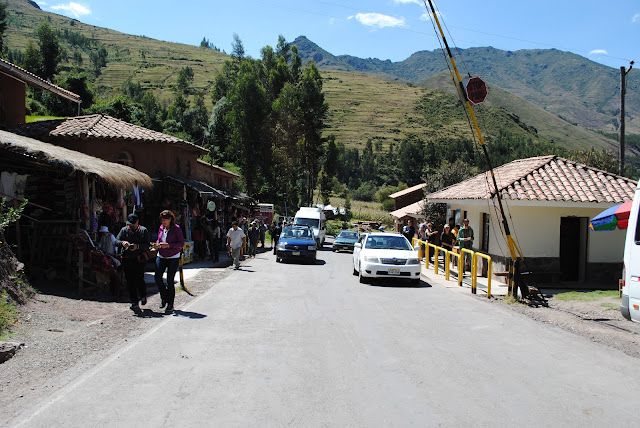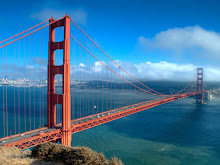Our first stop was an organized market pretty much in the middle of nowhere. It wasn't part of a town or anything. It must just be in a centralized location where locals can come and buy or sell produce and clothing. Doubt it, but really I think it's just strictly for tourist to stop during tours like the one we were on. The market was a big circle with lots of tenants or stalls (whatever you want to call them) lining the walkway. The picture looks blue because of the center sky light had a blue tint to it casting the blue hue. And you thought I couldn't say the word blue three times in one sentence!
We really kind of enjoyed bartering with the locals. Some were tougher than others, but with all them selling basically the same items, we knew we could always walk away and buy it somewhere else. They mainly all spoke English, but this was always the fun way to test my Spanish skills. We bought a nice ceramic cup from this lady. She seemed pretty happy after the sale. Then I flexed my "still-know-a-bit-of-Spanish" muscles once more and asked if I could take her picture... in Spanish of course.
While waiting for the rest of our group to board the bus we were intrigued by a couple alpacas, a baby pig and a little girl who looks like is picking her nose.
Seriously how cute is that pig?! I tried to snap more pictures of it, but people kept showing up and wanting to hold him (or her?). Joe's brother requested that he take a picture with an alpaca so we made sure to make Trav happy. I told Joe to go stand next to one of the alpacas quickly before the lady noticed. Well we weren't quick enough because she noticed and made Joe pay her. It wasn't much, but still!
Back on the road we started to spot snowcapped mountains! I did mention we were basically in the clouds, right?
The bus stopped along the road at a look-out. You can barely see the snowcapped mountains in the background, but the valley below is the Urubamba Valley. It was a gorgeous view and a great opportunity to take a few pictures.
And after a bit we got restless to get the tour moving so we killed time by taking some fun pictures. Look, I can reach up and touch the mountain!
This was the gate we stopped the bus at, all got off and showed our tourist ticket to get into the historical ruins of Pisaq. The tourist ticket (or boleto turistico in Spanish) was something we purchased through our travel agency. It was good for ten days and got us into places like Pisaq, Q'enqo, Tambomachay and Saqsaywaman. Basically most of the Inca ruins around the region and each time to went to a location the guard would punch your ticket for that location. It was like collecting stamps in a passport or something!
Quick photo opp before our history lesson from our tour guide. By the way our guide's name was Ernesto, or he said we could call him Ernest. I didn't get any pictures of him, but he did a great job. It has to be an exhausting job to lead tours like this for an entire day. I do appreciate that all the guides we had during our trip definitely had passion for the history. Maybe they were descendants of the Inca heritage or they were just proud of their country's history, it didn't matter to us.
Here's a bit of info from our map about Pisaq: Archaeologial park contructed at more than 3,300 m (or about 10,800 ft) with masterly and intriguing stone constructions. It was a large city which included several neighborhoods, two tunnels and the terracs of Patapata and Aqchapata connected them to the largest Inca cemetary. Every Sunday in the main plaza of the picturesque Mestizo town takes place a local market. In it's church the traditional mass in Quechua is chanted.
Side note, Ernesto said that Pisaq really doesn't translate into anything... however Pisaqa (adding an "a" at the end) means partridge in Quechua. It is believed that the town used to be called Pisaqa after the small bird.
Can you spot the holes in the hillside? Those were actually tombs! I think Ernesto said that when this town was discovered they found 1,500 mummified Inca bodies. Each and every Inca that passed away was mummified. Most were placed in the fetal position because they believe you came into this life in the fetal position and so you should leave this world in the same position. Although the important people (kings and the like) were mummified standing up. I guess it's a power thing.
Can you see the buildings beyond the terraces? It's amazaing how some of these Inca towns were perched up on top of a mountain or hill. They must have been in some serious shape to live up here like they did!
Joe strikes again with the door!
I'm not sure why we wanted a picture here, but it shows amazing stone work and the backdrop was kinda neat. The lady that took this picture was from Canada. We had a nice chat before continuing on.
We wandered around Pisaq for a while. I think our guide gave us 20 minutes free time after he spoke about the place. We headed straight to the top since we knew 20 minutes wasn't much time with the maze we had in front of us. It was a workout to climb to the top (I did mention that the people who lived here must have been in really good shape, right?) But the time and effort was well worth it.
We stopped in the small town of Urubamba for lunch. The lunch buffet was already paid for through our travel agency. After grabbing some items on our plate we sat down and decided we weren't sure what some of it actually was. Our guess was alpaca for one dish and salmon for the other (I kid, we knew it was salmon, but the dark meat... who knows!) Again I made the mistake of choosing Coke Zero to drink. I thought maybe, just maybe since it was not regular Coke that maybe it would taste more like the Coke we know in the United States. I was wrong. In turn I went back and grabbed a Sprite... score, this tasted amazing. Then I screwed up again when the guy running the restaurant told us that drinks weren't included in the buffet and Joe had to pay for all 3 bottles. Whoops!
This is a really great picture of what most of the houses throughout Peru looked like. On the roof were two bulls flanking a decorated cross. I believe it symbolizes security and safety for the family living inside. We were so intrigued we ended up buying two small ceramic bulls just like these. Does it still work if we don't have the cross in between? Of course we don't plan on putting them on our roof... what were you thinking?!
On to our next stop and what might have been our favorite from the trip (besides Machu Picchu of course!), Ollantaytambo (Oh-yawn-tay-tom-bo... it's really fun to say, please say out loud): A beautiful Inca town that preserves vividly Inca urban planning with houses, streets and waterways, and was safeguarded by a breathtaking fortress with its temples, hillside farming terraces and walls. The squares and streets follow a purely pre-Columbian architectural layout and style. The urban layout of straight narrow streets with houses inhabited by the direct descendants of people who lived there in Ica times, make this town a very interesting place to get to know. A strategic place that dominates the whole valley. Ollantaytambo was a military, religious, administrative and farming complex, built on top of two mountains. The Patakancha River divides the town in two parts. on where houses are found and the other where ceremonial buildings were erected around the Manya Raqui square. It was a strategic military headquarters.
In order to get to the actual ruins we first walked through the market.
Then we began our climb up the stairs next to many terraces. At this point we decided to break off from our tour and explore on our own. After only getting a limited time at Pisaq we wanted to make sure we got the chance to explore Ollantaytambo completely so we took off. Once again, getting to the top was a workout! By now I probably sound like I'm complaining about all the walking and climbing we've done. Let me assure you I do not mean to complain, it was great to be outside and get a bit of exercise in. Plus I want to make sure I'm preserving our memories correctly!
See, here is a much smaller doorway. Joe is standing straight up and his head actually touches the top!
Because we didn't listen to the full tour I couldn't really tell you what everything was here. It was still great though because we got to walk around at our leisure and explore while snapping a few pictures. You're right, when I saw a few pictures I mean more like 100 (at least) for the day.
I wish it wasn't so shaded and hard to see, but this view was amazing. Ollantaytambo was the largest of the Inca towns around the area.
More details!
My turn to model and show the rocks to scale.
You thought Joe was done with the doors? You thought wrong!
Enough about the precision with the stones, check out how straight and exact these terraces are! If they weren't constructed for farming purposes they were meant to prevent erosion on the mountainside. Especially up in the jungle area (where Machu Picchu is located), mudslides are pretty common during the rainy season so the terraces helped prevent them.
The trapezoid shapes are common among Inca architecture. This helped make their buildings more earthquake resistant. I already said how advanced their work was, it's amazing they knew that with the trapezoid doors and window would help distribute the weight and pressure during an earthquake. I guess they learned the hard way... earthquakes are somewhat common in this region.
Ok this is the last one, I promise. Notice the slight trapezoid shape?
After walking pretty much the entire grounds we needed to give our legs a rest. Also, we spotted the rest of our crew high above still making their way down so we had some down time. I posed in front of a fountain.
Across the walkway Joe posed with the ruins in the background. This is one of my favorite pictures from the trip. I love taking pictures of Joe!
Back on the road we go. It wasn't easy and most of the pictures didn't turn out at all, but we snapped a few from the bus while driving. Again we spotted the snowcapped mountains!
I actually like that the foreground is blurry in this pictures. It shows movement, yet still has a very pretty backdrop.
Last stop on the tour was Chinchero (you can just sound that one out). Here's some background: The superb landscape of the Vilcanota Mountains, the snow-capped Chicón and Wakay Wilka, a colorful traditional Sunday market, Inca structures and Colonial buildings erected on them make this town a rare jewel. The remains of the royal estate of Inca Tupa Yupanqui are found here. It was a farming center. The major sights include the Sunday market, where local people barter their produce, the remains of Inca Tupac Yupanqui's palace, the Colonial church built on Incan foundations and the perfect hillside farming terraces. Today a spectacular splash of color and movement, it fascinates most tourists, with a nice offering of artisanal works and textiles that reflect a purely pre-Colonial style. Two beautiful takes are visible from the Chinchero esplanade: Piuray and Huaypo.
Chinchero was very pretty especially since the sun was starting to set and we had a nice dusk color.
The church was pretty amazing. Like the description said above, the foundations were all Inca (you can tell by the precision of the stones) but the actual building was erected by the Spaniards (meaning it was of the Colonial era) showing the very different techniques.
We stepped inside the church and Joe tried to snap a picture quick. This time the guy right inside the door was on his game and said right away "no fotos!" Bummer. Although I give Joe props for this picture below, he took it on his phone and I really like it!
Locals were still on the grounds selling their goods even though it was getting dark and it was pretty cold. Chinchero was the highest elevation of the places we visited, about 12,300 ft. and my sweatshirt wasn't quite enough for comfort.
Some of the locals in this town still speak the Quechua language showing you just how remote and true to their roots they are.































































No comments:
Post a Comment